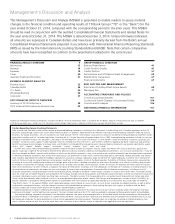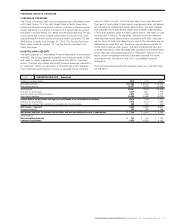TD Bank 2014 Annual Report Download - page 20
Download and view the complete annual report
Please find page 20 of the 2014 TD Bank annual report below. You can navigate through the pages in the report by either clicking on the pages listed below, or by using the keyword search tool below to find specific information within the annual report.-
 1
1 -
 2
2 -
 3
3 -
 4
4 -
 5
5 -
 6
6 -
 7
7 -
 8
8 -
 9
9 -
 10
10 -
 11
11 -
 12
12 -
 13
13 -
 14
14 -
 15
15 -
 16
16 -
 17
17 -
 18
18 -
 19
19 -
 20
20 -
 21
21 -
 22
22 -
 23
23 -
 24
24 -
 25
25 -
 26
26 -
 27
27 -
 28
28 -
 29
29 -
 30
30 -
 31
31 -
 32
32 -
 33
33 -
 34
34 -
 35
35 -
 36
36 -
 37
37 -
 38
38 -
 39
39 -
 40
40 -
 41
41 -
 42
42 -
 43
43 -
 44
44 -
 45
45 -
 46
46 -
 47
47 -
 48
48 -
 49
49 -
 50
50 -
 51
51 -
 52
52 -
 53
53 -
 54
54 -
 55
55 -
 56
56 -
 57
57 -
 58
58 -
 59
59 -
 60
60 -
 61
61 -
 62
62 -
 63
63 -
 64
64 -
 65
65 -
 66
66 -
 67
67 -
 68
68 -
 69
69 -
 70
70 -
 71
71 -
 72
72 -
 73
73 -
 74
74 -
 75
75 -
 76
76 -
 77
77 -
 78
78 -
 79
79 -
 80
80 -
 81
81 -
 82
82 -
 83
83 -
 84
84 -
 85
85 -
 86
86 -
 87
87 -
 88
88 -
 89
89 -
 90
90 -
 91
91 -
 92
92 -
 93
93 -
 94
94 -
 95
95 -
 96
96 -
 97
97 -
 98
98 -
 99
99 -
 100
100 -
 101
101 -
 102
102 -
 103
103 -
 104
104 -
 105
105 -
 106
106 -
 107
107 -
 108
108 -
 109
109 -
 110
110 -
 111
111 -
 112
112 -
 113
113 -
 114
114 -
 115
115 -
 116
116 -
 117
117 -
 118
118 -
 119
119 -
 120
120 -
 121
121 -
 122
122 -
 123
123 -
 124
124 -
 125
125 -
 126
126 -
 127
127 -
 128
128 -
 129
129 -
 130
130 -
 131
131 -
 132
132 -
 133
133 -
 134
134 -
 135
135 -
 136
136 -
 137
137 -
 138
138 -
 139
139 -
 140
140 -
 141
141 -
 142
142 -
 143
143 -
 144
144 -
 145
145 -
 146
146 -
 147
147 -
 148
148 -
 149
149 -
 150
150 -
 151
151 -
 152
152 -
 153
153 -
 154
154 -
 155
155 -
 156
156 -
 157
157 -
 158
158 -
 159
159 -
 160
160 -
 161
161 -
 162
162 -
 163
163 -
 164
164 -
 165
165 -
 166
166 -
 167
167 -
 168
168 -
 169
169 -
 170
170 -
 171
171 -
 172
172 -
 173
173 -
 174
174 -
 175
175 -
 176
176 -
 177
177 -
 178
178 -
 179
179 -
 180
180 -
 181
181 -
 182
182 -
 183
183 -
 184
184 -
 185
185 -
 186
186 -
 187
187 -
 188
188 -
 189
189 -
 190
190 -
 191
191 -
 192
192 -
 193
193 -
 194
194 -
 195
195 -
 196
196 -
 197
197 -
 198
198 -
 199
199 -
 200
200 -
 201
201 -
 202
202 -
 203
203 -
 204
204 -
 205
205 -
 206
206 -
 207
207 -
 208
208 -
 209
209 -
 210
210 -
 211
211 -
 212
212 -
 213
213 -
 214
214 -
 215
215 -
 216
216 -
 217
217 -
 218
218 -
 219
219 -
 220
220 -
 221
221 -
 222
222 -
 223
223 -
 224
224 -
 225
225 -
 226
226 -
 227
227 -
 228
228
 |
 |

TD BANK GROUP ANNUAL REPORT 2014 MANAGEMENT’S DISCUSSION AND ANALYSIS18
NON-INTEREST EXPENSES
(millions of Canadian dollars)
12 13 14
$18,000
15,000
0
6,000
12,000
9,000
3,000
AdjustedReported
60%
50
40
30
20
10
0
EFFICIENCY RATIO
(percent)
AdjustedReported
12 13 14
EFFICIENCY RATIO
The efficiency ratio measures operating efficiency and is calculated
by taking the non-interest expenses as a percentage of total revenue.
A lower ratio indicates a more efficient business operation.
The reported efficiency ratio was 55.1% compared with 55.3% last
year. The adjusted efficiency ratio worsened to 53.4%, compared with
52.9% last year. Expenses grew faster than revenue primarily due to
higher investments to support business growth and higher enterprise
and regulatory projects, and productivity initiatives.
FINANCIAL RESULTS OVERVIEW
Expenses
AT A GLANCE OVERVIEW
• Reported non-interest expenses were $16,496 million, an
increase of $1,427 million, or 9%, compared with last year.
• Adjusted non-interest expenses were $15,863 million, an
increase of $1,473 million, or 10%, compared with last year.
• Reported efficiency ratio improved to 55.1% compared with
55.3% last year.
• Adjusted efficiency ratio worsened to 53.4% compared with
52.9% last year.
NON-INTEREST EXPENSES
Reported non-interest expenses for the year were $16,496 million,
an increase of $1,427 million, or 9%, compared with last year.
Adjusted non-interest expenses were $15,863 million, an increase
of $1,473 million, or 10%, compared with last year. The increase
in adjusted non-interest expenses was driven by increases in the
U.S. Retail, Canadian Retail, and Corporate segments. U.S. Retail
non-interest expenses increased primarily due to the full year inclusion
of Target, investments to support business growth, and the impact
of foreign currency translation, partially offset by productivity gains.
Canadian Retail non-interest expenses increased primarily due
to higher employee-related costs including higher revenue-based
variable expenses in the wealth business, the inclusion of Aeroplan,
investments to support business growth, and volume growth, partially
offset by productivity gains. Corporate segment non-interest expenses
increased primarily due to ongoing investment in enterprise and
regulatory projects, and productivity initiatives.
